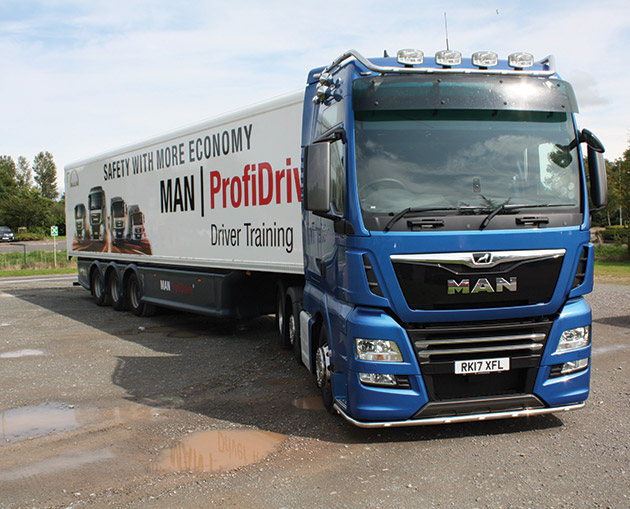
Operators always generate a demand for the biggest and best, and from the MAN stable it’s the TGX 26.640.
Usually the preserve of the heavy haulage sector, Kevin Swallow took the limited edition PerformanceLine version designed for traditional operators around the gruelling Transport News test route to see if all that power delivers.
SLOWLY but surely operators are moving up the evolutionary horsepower scale. Most have settled somewhere between the ‘gaffers’ 460hp and 500hp. What underpins the rising horsepower is rarely the work. All too often a 6×2 tractor unit boasting 500hp can be seen with fresh tyres on the mid-lift axle because there is rarely enough weight through the kingpin to encourage it to touch down.
Instead, choosing 500hp is the need to do a constant 56mph everywhere to utilise time and distance and cash in on the residual value.
Yet despite the growing trend, operators who choose something greater than a 500hp still stand out from the crowd. And at 640hp this test vehicle turned a few heads on the road and sparked a conversation or two at Kinross services on the M90.
The 640hp version of the D38 engine is something of a rare beast aimed squarely at the heavy haulage markets, but now the Germans are making it available for general trunking and tramping.
Last year the TGX 26.640 was given a limited edition status with 100 vehicles branded as PerformanceLine. The first was handed to BFS (Business Fleet Services), Stegmaier Group’s hire division, based in Germany.
So what makes the PerformanceLine specification? There are mirror covers and the lower radiator grille screen is coloured ‘anthracite’ (grey). There are chrome horizontal radiator slats, an increasingly popular sun visor fitting and two compressed air horns. It comes in a nifty ‘steel blue’ paint job and in case you forget what you are driving ‘PerformanceLine’ is written on the door.
The interior sticks to the blue theme with stitching highlighting the multifunctional leather steering wheel, high comfort seats and floor covering. The seatbelt is blue as is the inside of the curtains and on the brushed aluminium inlays on the dashboard.
STEADY EVOLUTION
Since the introduction of Euro 6, TGX has gone through a steady evolution in terms of appearance from the Euro 5 model, and we touched on this with the TGX 26.500 Efficientcruise road test (TN, March 2018). To briefly recap; externally the lion moves up to the chrome strip, the A posts and the corner deflectors were redesigned and a new plastic bumper was introduced with a ‘slatted’ structure to improve the air flow into the engine
In late 2015, MAN launched its Euro 6 straight six 15.3 litre D38 engine to replace its 16.2 litre V8 D28. At the tail end of 2016 MAN tweaked the D3876 to meet the latest and more stringent Euro 6c emissions controls, which the European Commission introduced at the beginning of 2017.
The theme for the D38 was more power and torque, so the outgoing 520hp and 560hp variants became 540hp and 580hp respectively. Each received an extra 200Nm of torque to 2,700Nm and 2,900Nm.
Performance of the range-topping unit remains unchanged at 640hp and 3,000Nm torque, which is the specification for this Transport News road test. The D38 640 actually delivers 631hp from 1,800rpm, and the torque works best from 930rpm through to 1,400rpm.
Fitted with the well established Tipmatic 12 speed (which is the ZF Traxon) with direct top gear, it is also specified with the EasyStart, which allows the driver to ease away from a standing start in idle. It has EfficientRoll, or eco-roll, but not EfficientCruise, launched at the same time as the revamped engines in 2016.
Having already driven the TGX 26.500 with EfficientCruise it has to be said using the traditional cruise control for this road test feels like a retrograde step. This is because you realise just how blunt a tool it really is. You simply crack on, and let the overrun, set at 5km/h, deal with excessive speed on the descents.
Thankfully EfficientRoll does take the edge off it on the undulating section of the M74, but apart from that this road test is strictly old school.
We got a taste of things to come as we roared up Beattock. Tackling the M74 at 52mph, our road test speed to keep us out of trouble with professional truck drivers. We climbed the first part from J15 northbound gradually closing the gap with other trucks freighted at 44 tonnes GVW. As we went into the dip the power eased off and momentarily introduced the engine brake before romping up and passing several trucks that had overtaken us near Ecclefechan.
Once we settled back down, the engine happily lugged along at 1,190rpm. It runs on a 2.53:1 rear axle ratio as standard. With around 300rpm to work with, the 640 took any ascents without changing gear or even slowing down. In fact it wasn’t until we got baulked heading up the start of the M73 towards Stirling that we were forced to change down the box.
On the M73 towards Denny and the M80 north past Stirling we deployed the adaptive cruise control (ACC) through what can be a busy section. ACC usually gets a bad press as it slows progress, but in heavy traffic it can prove invaluable as it has the capability to spot something before you do.
At this point, I realised just how enjoyable it is to drive a truck with so much power at its disposal. At no point had the truck laboured, I know it shouldn’t, but a lifetime spent driving under powered wagons makes you appreciate something different. With that ‘eureka’ I understood why you might go for something so excessive.
As we started the A9 towards Perth thoughts turned to the timed hill climb at Cairnie Braes, and whether this truck would set a new record. Using 631hp and utilising the 3,000Nm of torque we dropped to 10th gear, like all the previous climbs with other trucks, and at 40mph.
TGX 26.640 reached the top in 3mins 17secs. That is 10 seconds quicker than the TGX 26.500, which dropped to 36mph. Despite possessing the highest horsepower and most torque to go around the route it was two seconds slower than the Volvo FH540 6×2 tractor unit (TN, January 2018) that boasted 532hp and 2,600Nm torque from its 12.8 litre driveline. I blame the driver!
SPEED MEMORY
Once we got onto the A702 southbound from Edinburgh towards Abingdon we employed the brake pedal memory. By tapping the brake pedal you set a speed memory so when you reach it again the engine brake kicks in automatically.
At 40mph the revs sit down at the 1,000rpm mark, which makes it liable to frequent changes for the numerous inclines. It has to be said on the A9, which is a dual carriageway, and sat at 50mph and 1,090rpm the difference is dramatic. As the engine prefers to lug down, a gear change is rare.
If you buy a TGX PerformanceLine you’ll be pleased to know it comes with the XXL sleeper cab, the biggest option available. It adds 85kg to the kerbweight compared to the XL cab, and 45kg compared to the XLX. Overall at 8,725kg it is 350kg heavier than the TGX 26.500.
From the footwell, standing room is 2,150mm and with the engine tunnel rising 120mm, standing room in the centre of the cab is 2,030mm, which is 6ft 6in. By comparison the standing room on the engine tunnel is 1,820mm (5ft 10in) in the XLX cab and 1,540mm (5ft) in the XL.
Ignoring the swish PerformanceLine enhancements, like the blue embossed Lion on the underneath of the top bunk, the XXL cab is a fine environment from which to work and rest.
The upper bunk is 700mm wide and 2,125mm long, with 640mm headroom. For the resident downstairs the bottom bunk is 75mm longer, 90mm wider and they enjoy an additional 150mm in headroom.
A slide out cool box/fridge is located underneath the bottom bunk that also has a handle which opens up into a table. More storage is found behind both seats that can be accessed from outside. From the centre dash are two pull-out drawers and there are three storage lockers above the windscreen.
Let’s be honest, most hauliers will not need the best part of 640hp and 3,000Nm torque to move 22 pallets of dry goods from one end of the country to the other.
What this does give you is consistency, in that it will retain a higher average speed by ironing out the peaks and valleys.
That power made the first section from Carlisle to Perth (138 miles) a full two minutes quicker than the Volvo FH540, and three minutes faster than the MAN TGX 26.500. It might not sound a lot, but it’ll add up to more than 20 minutes during the week if a truck covers 1,600 miles.
What is more, the days of having a flagship motor are back (see sidebar). Of course, you’ll pay extra to acquire a limited edition truck, but its rarity and specification means you should realise that capital investment from the residual if, or when, you come to sell it. And besides, it’s a cracking good truck to drive.




